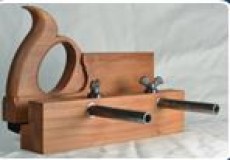

Info copied from Btalckburn Tools site
http://www.blackburntools.com/new-tools/new-saws-and-related/rebate-saw-plane/index.html
While the most recent reincarnation of this hybrid saw-plane has been branded a "kerfing plane" by Tom Fidgen, this form has been around for centuries.
Although early versions (including the stair saw and the joinery saw described by Roubo in 1769) had a saw blade mounted in a plane body, they lacked the fence that make this saw-plane so useful for certain ripping operations.
In 1866, a patent was granted to Daniel Whitker for his "saw-rabbet plane", the earliest documentation I have found of a fence being added to this form. In his patent application, he described the plane as a "...new and useful tool or instrument for rabbeting and plowing or grooving lumber...". These functions are just as useful as kerfing a board for resawing.
Rebate saw-plane blade specifications and features:
The blade can be purchased sharpened and set (ready to install out of the box) or unsharpened. The unsharpened blade comes with the triangular portion of the teeth punched; you will need to sharpen and set the teeth, then file in the rounded gullet bottom. Sharpening requires an 8" Regular taper saw file (available below or here) and a 5/32" chainsaw file (available at any good hardware store).
Fence hardware specifications and features:
While the hardware installation is straightforward, it does require some precision to ensure proper function. You will need a drill press, good 3/16" and 7/16" brad point bits, and 9/16" and 3/4" piloted counterbores (with a 3/16" pilot) or Forstner bits (the counterbores are easier to use, but more expensive).
Plans for making your own rebate saw-plane are available as a pdf at the link in the upper right corner of this page. The plans include sources and part numbers for the needed tooling.
Use the rebate saw-plane for:
Made in the USA.


